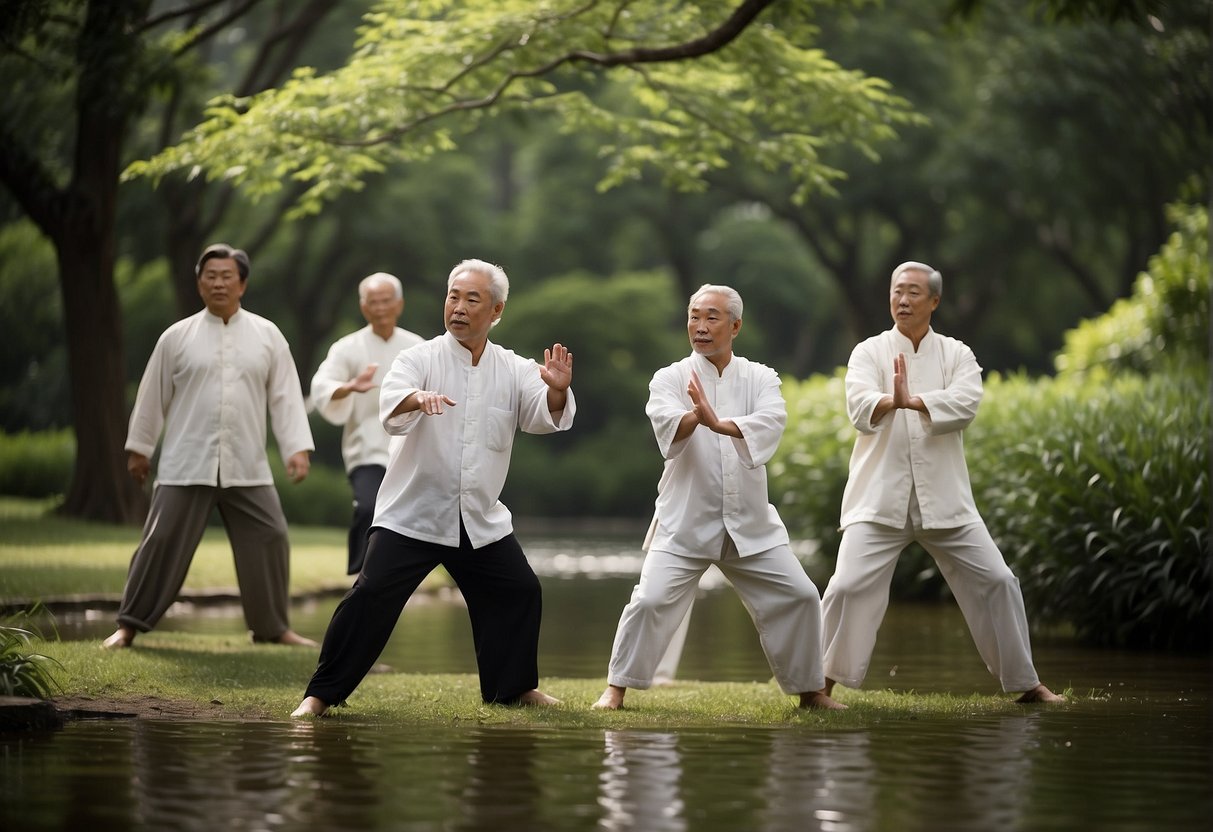For men over 50, Tai Chi is an excellent option that caters to the need for low-impact movements and enriches mental well-being. This ancient Chinese practice, characterized by its slow and flowy movements, has served people of all ages for centuries, promoting better balance, flexibility, and peace of mind.
Embarking on Tai Chi For Men Over 50 journey introduces us to its fundamentals. It encompasses more than physical activity; it’s a blend of meditation, breathing, and deliberate movements. This is particularly beneficial as we face age-related physical challenges and seek ways to prevent injury while staying active. Furthermore, integrating Tai Chi into our daily lives provides a sustainable practice that enhances quality of life and supports continued personal growth.
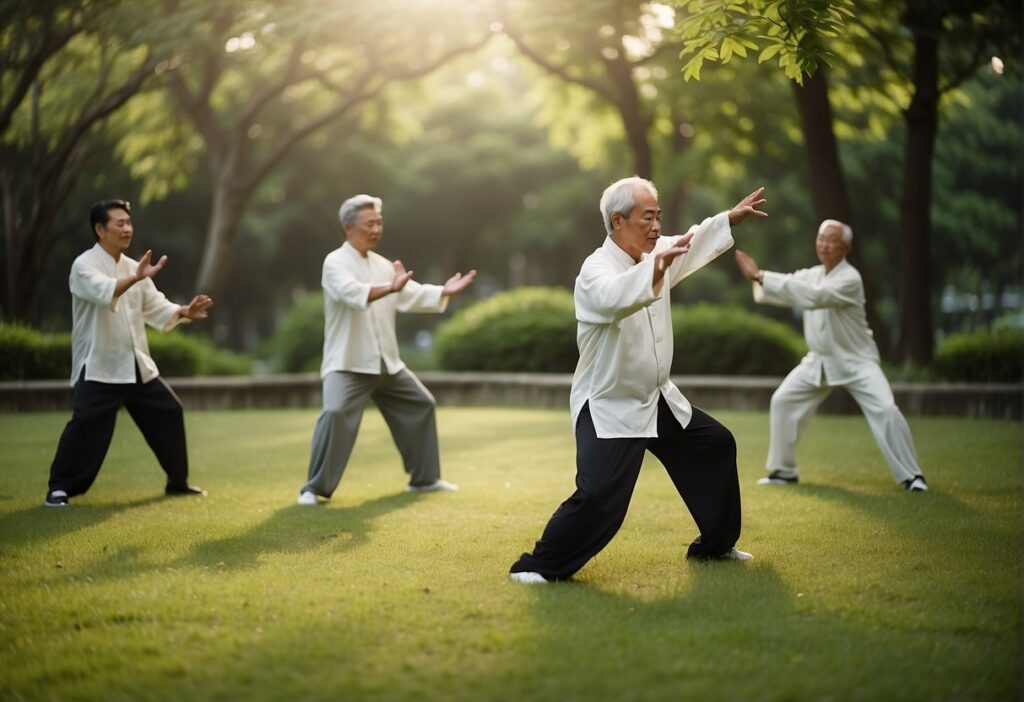
Tai Chi Fundamentals & Philosophy
Tai Chi is a practice rich in tradition and philosophy that aims to enhance physical and mental health. The philosophy of Tai Chi emphasizes the balance of opposing forces, known as Yin and Yang. This concept is foundational to our understanding of Tai Chi and dictates a harmonious flow in our movements. It encourages the cultivation of the body and mind to achieve a state of equilibrium and inner peace.
Chi, or Qi, is the life energy that flows through all living things, and it’s central to the practice of Tai Chi. In our exercises, we aim to harness and improve the flow of Chi, enhancing our vitality and health. Our movements are designed to guide and balance this energy, leading to improved stability and strength, which is especially crucial for us as we age.

Health Benefits
In our exploration of Tai Chi for men over 50, we discover a wealth of health benefits that are especially important as we age, focusing on balance, joint health, cardiovascular fitness, and mental well-being.
Improving Balance and Stability
Tai Chi significantly improves balance and stability. This martial art emphasizes slow, deliberate movements that help us enhance our coordination and proprioception, reducing the risk of falls which is a common concern for men over 50. Forbes Health correlates Tai Chi with better balance and improved immunity.
Enhancing Joint Health
Joint health is imperative to maintaining an active lifestyle. Tai Chi’s low-impact nature ensures we can nurture joint mobility without causing undue stress. The gentle, flowing motions aid in reducing stiffness and improving the range of motion, which is essential for joint maintenance and health.
Cardiovascular Improvement
Even though Tai Chi is a low-intensity workout, it effectively promotes cardiovascular health. By practicing Tai Chi, we experience an increased heart rate at a safe level, which can help improve heart health over time. It is a beneficial form of exercise for cardiovascular maintenance without the risks associated with high-impact aerobics.
Stress Reduction and Mental Health
Our mental health is just as important as our physical health. Tai Chi is praised for its stress-reducing properties. It encourages mindfulness and deep breathing, improving mental and emotional well-being. The meditative aspects of Tai Chi help us achieve a state of relaxation and mental clarity. Healthline suggests the anecdotal evidence of Tai Chi in stress reduction and anxiety.
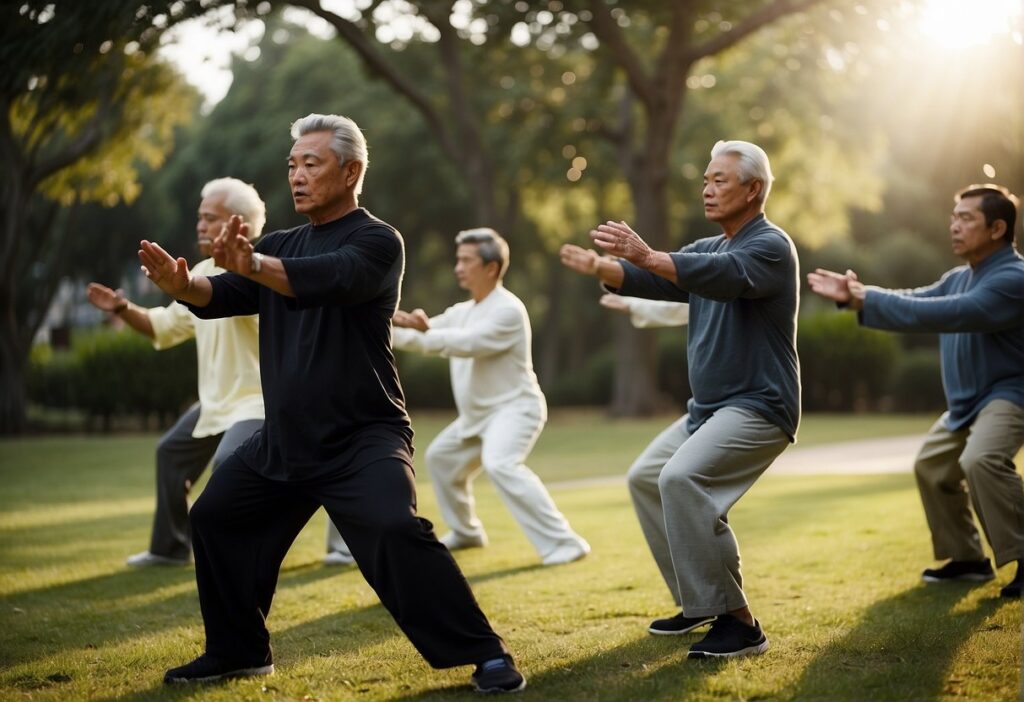
Tai Chi Styles and Forms
Three major styles of Tai Chi, each especially suitable for men over 50 include Yang, Wu and Chen style. Each offers unique aspects to practice and master.
- Yang Style Tai Chi is known for its gentle, flowing movements that promote relaxation and health. It’s particularly well-suited for those starting Tai Chi later in life because it emphasizes slow, deliberate motions that encourage bodily awareness and balance without strain. Yang Style is recognized for its accessibility and is often recommended as the optimal Tai Chi form for seniors, making it an excellent choice for men over 50 looking to maintain flexibility and reduce stress.
- Wu Style Tai Chi distinguishes itself with a stronger focus on internal development and subtle body alignments. Its characteristic stance, with slightly leaned-forward postures, challenges practitioners to develop a more profound sense of center and stability. This style may be more intricate, but it is still approachable for men over 50 who wish to cultivate a sense of inner strength and precision in their movements.
- Chen Style Tai Chi stands out as the original style from which other styles have evolved. Slow, meditative movements and sudden bursts of power characterize it. While this style can be more physically demanding, it offers a dynamic range of motions that can be deeply rewarding and empower practitioners to explore the full breadth of Tai Chi’s martial origins. Men over 50 interested in a more vigorous practice may find Chen’s Style challenging and invigorating.
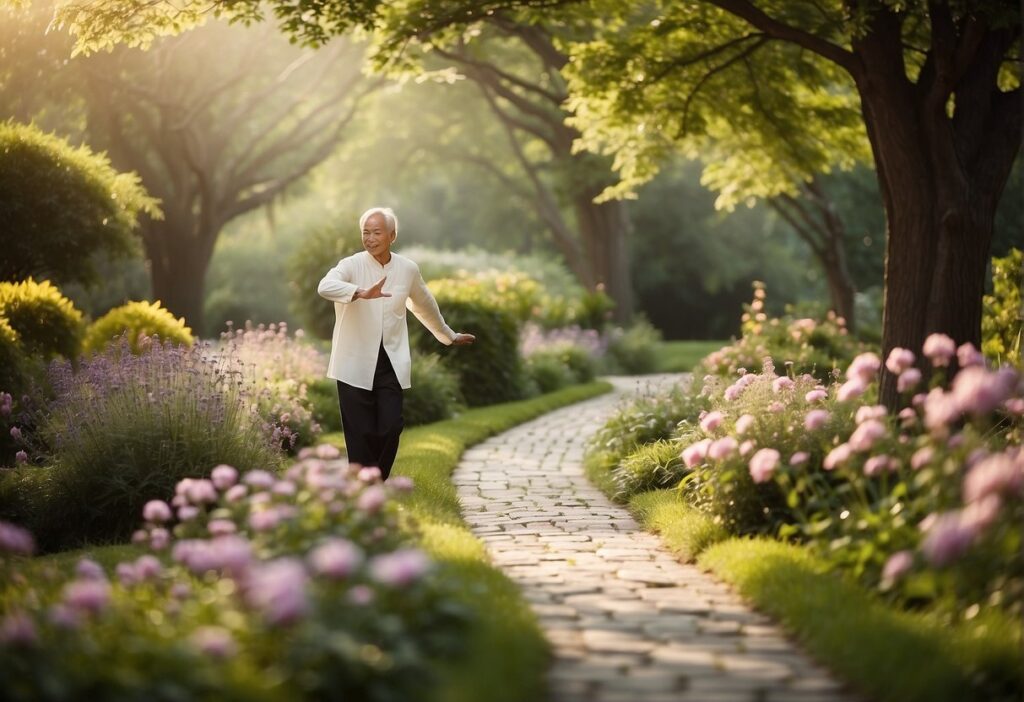
Getting Started
Your journey starts with choosing the suitable class, obtaining the necessary equipment and attire, and setting achievable goals as these will be your foundational steps.
Begin by finding a Tai Chi class that matches your skill level and physical condition. Look for classes designed specifically for seniors or beginners. Watching a class before participating can provide insight into the instructor’s teaching style and atmosphere. The article “Tai Chi for Seniors: Benefits, Beginner Tips, and Resources” has valuable information for tailored recommendations.
Tai Chi requires minimal equipment, making it accessible for all. When shopping for tai chi garments choose loose, comfortable clothing that allows unrestricted movement and flat-soled shoes to maintain balance and stability. There’s no need for specialized gear, but comfort is critical to maintaining the correct form and preventing injury.
Now that you have a class and equipement, set realistic goals reflecting your fitness and health considerations. It’s essential to start with short, manageable sessions and gradually increase duration as you gain strength and confidence. It’s not about how quickly you progress but how consistently you practice.

Technique and Practice
To familiarize you with Tai Chi lets look at the fundamental techniques crucial for men over 50 practicing Tai Chi. The focus will be on warming the body, mastering basic movements, and controlling breath to ensure a safe and effective Tai Chi experience.
Warm-Up Exercises
Before immersing yourselves in the core practices of Tai Chi, prepare your body with warm-up exercises. These exercises help loosen joints, enhance circulation, and reduce the risk of injury. A joint warm-up exercise is standing with legs slightly wider than the distance apart and gently shifting weight from left to right. During this motion, a slight knee bend helps prepare the lower body for the Tai Chi stances you’ll soon practice.
Core Movements and Stances
The essence of Tai Chi lies in its core movements and stances. In Tai Chi for seniors, movements are designed to be low-impact, promoting balance and flexibility. For instance, when you practice “The Ward Off,” where one hand is pushed out as if gently repelling an object while the other stays near the chest, ready to defend, improves coordination but also gradually builds strength.
Breath Control Techniques
Breath control, or ‘breathing with intention,’ is a cornerstone of Tai Chi practice. As you execute each movement, synchronized breathing helps maintain balance and focus. The breath should be deep, steady, inhaled, and exhaled through the nose. The goal is to make breathing a conscious part of our movement, enabling the meditative state for which Tai Chi is known. Practicing breath control can be calming and is integral to the discipline.
Routine Development
Set consistent practice times to make Tai Chi a regular part of your life. Begin with short sessions, perhaps 10 minutes, and gradually increase the duration as you become more comfortable. Establishing clear goals, such as improving balance or reducing stress, will help maintain your motivation.
Week Frequency Duration
- 1-2 Twice a week 10 mins
- 3-4 Three times a week 15 mins
- 5+ Daily 20+ mins
Tai Chi at Home
Practicing Tai Chi at home gives us flexibility with our schedules. We can use resources such as online videos or DVDs to guide our practice. Choosing a quiet, open space where we can move freely is essential. Incorporation of simple Tai Chi tools like handballs can also enhance our experience.
- Morning: Start the day with a routine to energize.
- Evening: Use Tai Chi to unwind before bed.
As we deepen our journey into Tai Chi, advancing our practice beyond the basics is critical to experiencing the full benefits of martial arts. Dedication to mastering complex forms and engaging in workshops and retreats can significantly enhance our skills and wellness.
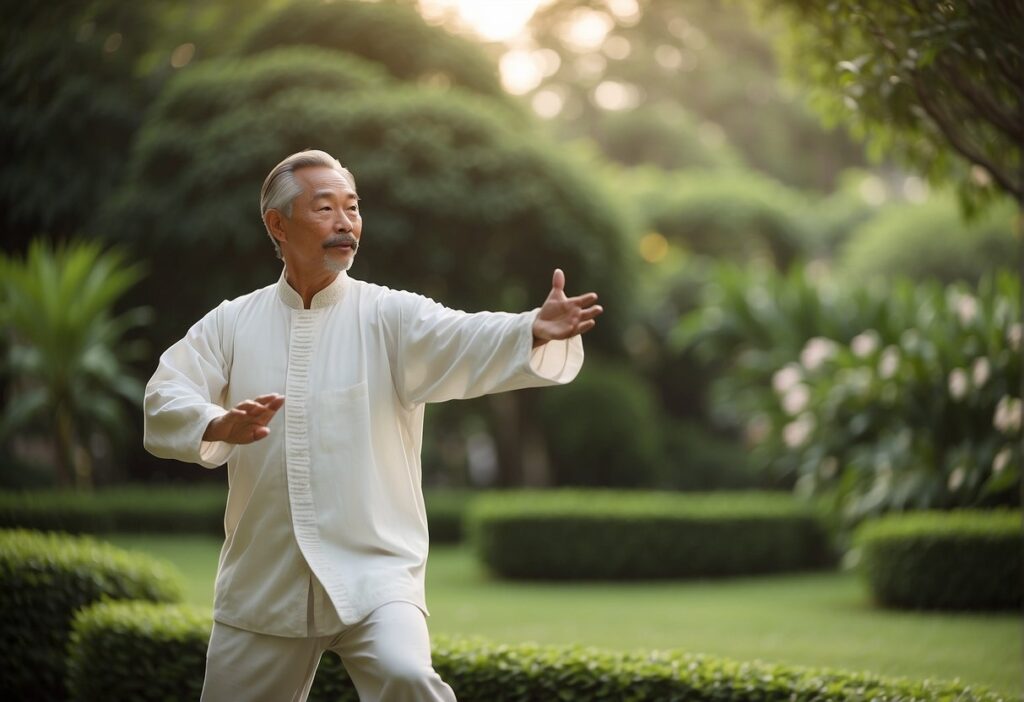
Tai Chi For Men Over 50 Resources and Support
When you approach the practice of Tai Chi, especially for men over 50, it’s essential to have the right resources and support to guide us through learning and practicing this art. Engaging with comprehensive books, seeking qualified instructors, and integrating into the Tai Chi community can significantly enhance our experience.
Books:
- “Tai Chi for Beginners” by Dr. Paul Lam: A step-by-step guide suitable for all ages.
- “The Harvard Medical School Guide to Tai Chi” by Peter Wayne: Insightful perspectives on the health benefits of Tai Chi, especially for older practitioners.
Online Material:
- Visit Tai Chi for Health Institute for instructional videos and resources.
- Utilize apps like “Tai Chi Step by Step” for easily accessible guidance through your Tai Chi journey.
Finding a Qualified Instructor
- Use the Tai Chi for Health website to find certified instructors in our area.
- Ask local community centers or fitness clubs if they host Tai Chi classes led by experienced professionals.
Joining the Tai Chi Community
- Local Tai Chi Clubs: Many communities have local groups that meet regularly. A search on Meetup can provide listings.
- Online Forums: Join platforms such as Tai Chi Reddit to connect with practitioners at all levels and share experiences.
Final Thoughts
Tai Chi presents a unique and valuable opportunity for men over 50 to enhance their physical and mental well-being. This gentle yet effective form of exercise not only improves balance and flexibility but also serves as a powerful tool for relaxation and stress reduction. By incorporating Tai Chi into your daily routines, you can enjoy the long-term health benefits that come from consistent practice, fostering a healthier, more active lifestyle as they age. Embracing Tai Chi can lead to a harmonious blend of body and mind, ultimately contributing to a more fulfilling life.
Frequently Asked Questions
What are the best Tai Chi exercises for beginners over 50?
For beginners over 50, starting with fundamental Tai Chi exercises is critical. Movements like The Wave Hands like Clouds support coordination, while The Golden Rooster Stands on One Leg improves balance and focus.
In what ways does Tai Chi differ from yoga in terms of benefits for men over 50?
While Tai Chi and yoga improve flexibility and balance, Tai Chi’s unique focus on fluid motion and breath control can lead to better joint health and reduced stress, benefiting men over 50 who may need low-impact activities.
How does Tai Chi reduce stress and mental well-being in older men?
Tai Chi promotes a meditative state through mindful movement, helping to reduce stress, anxiety, and depression, which enhances the overall mental well-being of older men.

